Those Seeking God
THE MOST UNUSUAL HOLY PEOPLE OF CHRISTIANITY THROUGH ALL CENTURIES
The Saint with an Animal’s Head
We see him among the sacred paintings in Donji Korminjani near Gnjilane, in Sukovo near Pirot, Gornji Matejevac near Niš, Gradište near Petrovac at the Sea, St. Nikita near Skopje, Paraklisis of the Dormition of Virgin Mary in Chilandar... Who is he? Where was he born, how did he live, how did he die and how was he dedicated? Where are his relics today, where are the temples dedicated to him, what miracles mark his path? Where did he get the animal image and what does he remind us of? Why did he wake up in this earth? Why are his presentation existing only in Eastern Christianity and missing in the Western?
By: Branislav Matić
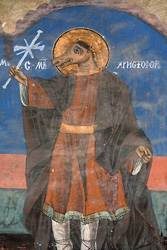 There are many paths leading to Christ. There are many paths leading to Christ.
Many mysterious ones.
St. Christopher, from the III century, presents one of the strangest known to us. Many masters have written about him, including St. Justin of Ćelije and Nikolai of Lelić, Patriarch Pavle and Veselin Čajkanović, Vladimir Nazor and Aleksandar Dugin. As well as some who have lost their way and found him, such as Erasmus of Rotterdam, whose folly is hard to praise. Only after we had understood the cross of St. Christopher, great literary works opened up to us, from the ancient Greek Pseudo-Kalisten and his novel on Alexander of Macedonia, to the White Dominican written by Gustav Mairink.
Still, it sometimes seems as if we know nothing, as if we have forgotten. As if we have irreparably failed our imagination which (Nabokov says) is only a form of memory.
FROM A DEMON TO HOLINESS
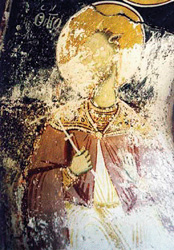 The story of St. Christopher has many beginnings, two exits and one ending. It is unknown where and when he was born, there is no agreement on the place of his martyrdom. It is certain that he lived at the time of the military emperor Trajan Decius (ruled from 249 to 251), the one ”born in the village of Budalija, the station eight miles from Sirmium in the direction of the western sunset”. Numerous hagiographies and legends flow into two main streams, the eastern and the western one. The story of St. Christopher has many beginnings, two exits and one ending. It is unknown where and when he was born, there is no agreement on the place of his martyrdom. It is certain that he lived at the time of the military emperor Trajan Decius (ruled from 249 to 251), the one ”born in the village of Budalija, the station eight miles from Sirmium in the direction of the western sunset”. Numerous hagiographies and legends flow into two main streams, the eastern and the western one.
The eastern legend states that young Reprobus originated from the clan of the doglike, cynocephalic. He had a huge human body and a dog’s head. Somewhere in the east, in the desert, seemingly in the deep part of Lycia, the army of emperor Traian Decius caught him and sent him to Rome, to the palace, for curiosity and for fun. The young man met Christians there, found Christ and accepted baptism. During the holy ceremony he suddenly received a human image, ”carried Christ” and was therefore named Christopher. The carrier of Christ.
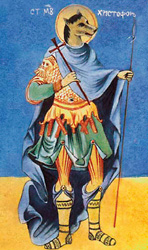 According to other eastern hagiographies, stated by Patriarch Pavle, Ioannou Ramfu, Papaevangelou and Justin Popović, the gigantic young man met Christianity earlier, believed in Christ, but wasn’t baptized. In an unknown city in the East, under Roman authority, he protected a Christian from pagan torturing. He knotted and upbraided the torturers. The outraged emperor sent 200 soldiers to catch and bring him. The bishop of Raška and Prizren Pavle, later Patriarch of Serbia, wrote in 1976: ”The soldiers fulfilled the orders of the emperor, however during their return they went out of bread. After the prayer of their prisoner, the breads they had miraculously multiplied and his dry stick blossomed. After having seen it, the soldiers believed in Christ and after their arrival to Antakya, bishop Vavila (238-250) baptized them and Reprobus. When he was taken before the emperor, the latter began flattering to revert him from Christ. It turned to be unsuccessful, so the emperor tried to debauch him by sending him two harlots, pagan women, Kalinika and Akilina. The holy man converted them to Christ too. Outraged, the emperor ordered the execution of the 200 soldiers and the two women and ordered terrible torturing for St. Christopher. The holy man, however, with the power of Christ, remained unhurt. Finally they beheaded him with a sword in the year 249 or 250. His body was bought from the soldiers by Peter, bishop of Atalia, and buried in his city.” (”How is St. Christopher painted”, Glasnik SPC, Beograd, March 1976, reprinted also in: Patriarch Pavle, Clarifying some issues of our faith, I, Beograd 1998, 204-213) According to other eastern hagiographies, stated by Patriarch Pavle, Ioannou Ramfu, Papaevangelou and Justin Popović, the gigantic young man met Christianity earlier, believed in Christ, but wasn’t baptized. In an unknown city in the East, under Roman authority, he protected a Christian from pagan torturing. He knotted and upbraided the torturers. The outraged emperor sent 200 soldiers to catch and bring him. The bishop of Raška and Prizren Pavle, later Patriarch of Serbia, wrote in 1976: ”The soldiers fulfilled the orders of the emperor, however during their return they went out of bread. After the prayer of their prisoner, the breads they had miraculously multiplied and his dry stick blossomed. After having seen it, the soldiers believed in Christ and after their arrival to Antakya, bishop Vavila (238-250) baptized them and Reprobus. When he was taken before the emperor, the latter began flattering to revert him from Christ. It turned to be unsuccessful, so the emperor tried to debauch him by sending him two harlots, pagan women, Kalinika and Akilina. The holy man converted them to Christ too. Outraged, the emperor ordered the execution of the 200 soldiers and the two women and ordered terrible torturing for St. Christopher. The holy man, however, with the power of Christ, remained unhurt. Finally they beheaded him with a sword in the year 249 or 250. His body was bought from the soldiers by Peter, bishop of Atalia, and buried in his city.” (”How is St. Christopher painted”, Glasnik SPC, Beograd, March 1976, reprinted also in: Patriarch Pavle, Clarifying some issues of our faith, I, Beograd 1998, 204-213)
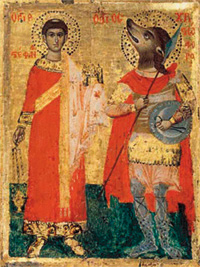 Some ancient Greek manuscripts describe this young man, later saint, as a dog-headed demon. He eats people and he cannot speak (since the word is a tool of God). Then an angel of God, after having prayed before the Crucified, touched the open lips of the dog-headed one. He turned into normal human form and started talking. The miracle echoed, ignited hope both of the fallen and the enslaved ones. Traian Decius then sent the 200 soldiers to catch and bring the giant… The rest you know. Some ancient Greek manuscripts describe this young man, later saint, as a dog-headed demon. He eats people and he cannot speak (since the word is a tool of God). Then an angel of God, after having prayed before the Crucified, touched the open lips of the dog-headed one. He turned into normal human form and started talking. The miracle echoed, ignited hope both of the fallen and the enslaved ones. Traian Decius then sent the 200 soldiers to catch and bring the giant… The rest you know.
At the other end, opposite of the dog-headed cannibal, is the legend of the handsome monk Christopher. Also eastern, originating from Mt. Athos, but later. It is stated by Kretchenbaher in his book Cynocephalic Demons (Munich, 1968), but he doesn’t understand it. According to the legend, a young monk was almost supernaturally handsome. Wherever he would show up, everyone would be pervaded by restlessness and temptation, ”the tremble of a fatal attraction one could hardly resist ”. Such a beauty became a burden to him who, pledged to Christ, found it harder and harder to bear. He didn’t succeed in truly dedicating himself to conciliation and knowing God. So he prayed to the Lord night and day to take away his beauty and return it to the place it, so big and grandiose, belongs to. One morning he woke up and realized that, instead of the previous, supernaturally beautiful one, he has an animal’s head. Shocked by the miracle he prayed for, the young monk ”completely dedicated himself to Christ and spent the rest of his life that way”. He became St. Christopher.
AND HE SAW ABOVE HIM THE HEAVENLY EYES
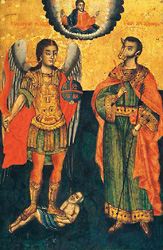 The western legend doesn’t mention the dog-headed one, but is not less exciting. It speaks about a man-giant from Palestine, gifted with incredible strength. Even in his earliest youth, he, Reprobus, decided to find the strongest one on earth to dedicate his life to him and to faithfully serve him. The western legend doesn’t mention the dog-headed one, but is not less exciting. It speaks about a man-giant from Palestine, gifted with incredible strength. Even in his earliest youth, he, Reprobus, decided to find the strongest one on earth to dedicate his life to him and to faithfully serve him.
He served many powerful landlords and stayed with them until he would realize that his master was trembling before his strength. Then he would move on to a stronger one. Going up such a stairway, he finally arrived to the prince of this world, Satan himself.
Once, a horrible escort wearing black cloaks, led by its master, riding over a hill suddenly arrived to a big Christian cemetery with a chapel. The crosses shined in the moonlight, the horses stopped at the spot, a horrible cry tore the night. Like a soap bubble, the illusion disappeared.
The man was alone when it dawned, at the edge of the old cemetery, the ”thick woods of crosses”. After realizing that the horrifying master ran away from the Cross, he decided to seek the one whose sign that was. He spent a while with monks in the desert who taught him about Christ. However, he and the spiritual people of the desert were clear that his path to Christ is not the one of a monk. Thus he went into the world to find a different one. Vladimir Nazor, in his romance Legend on St. 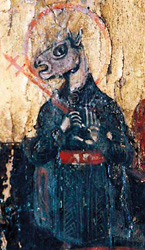 Christopher, published by the Serbian Literary Herald in 1922, wrote: ”Reprobus came out of the desert. He wandered through villages and cities, met all kinds of people; he was a plowman, worker and soldier, prayed in catacombs, he was tortured and banished, but couldn’t found Christ anywhere. The Christians served the savior the way he couldn’t.” Christopher, published by the Serbian Literary Herald in 1922, wrote: ”Reprobus came out of the desert. He wandered through villages and cities, met all kinds of people; he was a plowman, worker and soldier, prayed in catacombs, he was tortured and banished, but couldn’t found Christ anywhere. The Christians served the savior the way he couldn’t.”
And so he came to a wild river, one that couldn’t be tamed or crossed, the one that refused a bridge over it. With his gigantic posture and incredible strength, he fought the force and conquered it. He walked to the other bank and returned. Then he took the advice of a spiritual man to stay there and help the people by carrying their loads from one bank to the other. ”At the beginning he did it all out of spite towards the river, however then began doing it for love towards the people. He carried over a friend to a friend, a son to a mother, a husband to a wife. (...) A war broke out on the other side of the river and he saved many people under a storm of arrows and rocks. Wounded, bloody, he carried over children, old people; he took the wounded out of the river, saved cattle to the runaways…”
Once, at dawn, at the time of great floods when no one crossed even the narrowest streams, a boy called him and asked him to carry him over a flooding river. The giant took him and carried him with ease. After a few steps in the water, he could hardly move from the weight. He stopped in the middle of the current and couldn’t go further. He looked at the boy and saw heavenly eyes sparkling above him. The voice of Christ thundered: ”I am Christ, the savior of the world! The one who had taken all the weight of Sin on him. Today, you have carried the heaviest weight on your back. Therefore from now on, you will be called Christopher. The one who carries Christ.”
And so the one who entered the river as Reprobus, the Cursed One, was baptized in it and came out to the other bank as the carrier of Christ.
WHEN A DRY STICK BLOSSOMS
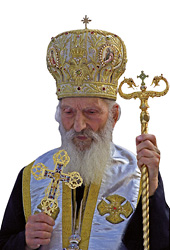 This is how Patriarch Pavle describes him: This is how Patriarch Pavle describes him:
”... The weight became so heavy that his strong shoulders bent to the water surface and his powerful chest breathed with strain. After finally arriving to the other bank and taking the child off his shoulders, he could barely find the strength to ask: ‘How come you are so heavy, child!? I felt as if I were carrying the whole world on my back!’
‘More than the world’, replied the child, ‘you were carrying the one who created the world. You have showed mercy and mercy will be shown to you: your sins are forgiven and My hand, while you were carrying me, baptized you in the water. To prove you these words – your dry stick will blossom.’
After having said that, the child disappeared and the giant became known as the carrier of Christ, Christopher.
After meeting Christ in person, St. Christopher began diligently preaching about him and finally arrived to Asia Minor, to the province of Lycia, where he converted many pagans with the miracle of his stick blossoming. However, he was caught there, thrown into the dungeon, tortured and finally killed as a martyr. The unknown city of Sarmon is mentioned as the place of martyrdom of the holy man, from where his relics were transferred to the Spanish city of Toledo, and then to the Saint Denis Abbey in France.”
We have some indications that the place of martyrdom of St. Christopher is halfway between the symbolically important cities of ancient Lycia, both related to another important Christian saint. The first is Patara, a city where, shortly after the death of St. Christopher, St. Nicholas the Miracle Worker was born and where Nicholas’ uncle was bishop. The second is Lycian Myr, where St. Nicholas, after ”the invitation of the Lord to start a feat among the people”, was elected archbishop; a city where ”the Myrlycian” would be added to the saint’s name. During the prosecution of Christians under Diocletian (284-305) and Maximianus (285-305; 310), Archbishop Nicholas was also thrown into a dungeon, seemingly the same one where St. Christopher ended his earthly life.
BENEVOLENT GIANT AND DOG-HEADED SAINT
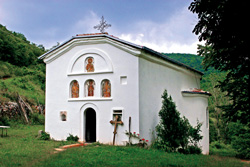 St. Christopher is respected both in the East and in the West, especially among the Greeks and Spaniards, who have testified about the great miracles by his relics. The Orthodox Christians celebrate him on May 9th, Roman Catholics on July 25th, Armenians on July 14th, Copts on August 3rd, Jakovites and Melchites on the 7th and 27th of April. St. Christopher is respected both in the East and in the West, especially among the Greeks and Spaniards, who have testified about the great miracles by his relics. The Orthodox Christians celebrate him on May 9th, Roman Catholics on July 25th, Armenians on July 14th, Copts on August 3rd, Jakovites and Melchites on the 7th and 27th of April.
He was presented with a face of a benevolent giant, young man or warrior-martyr in cave churches in Cappadocia, Veliko Trnovo, Staro Nagoričane, Lesnovo, Dečani, Annunciation in Kablar, Temska, Jašunj, Mt. Athos monasteries of Dohiar, Protaton, Great Lavra… ”Furthermore, there is a village of Christopher in the vicinity of Bitola, and in it a church with a same name, restored both in the early and the late XIX century”, states Ljiljana Stošić, expert of the Balkanology Institute of SASA, in her work The Cult of St. Christopher Cynocephalic in the Balkans.
The most unusual presentation of this saint is certainly the one with an animal’s head. Dog, horse, donkey-head (the presentations also differ depending on the observer). It exists only at the Orthodox Christian East, with some of the most interesting examples in Serbia.
The oldest such presentations of St. Christopher known today are on two clay icons from Vinica near Kočani. They originate from the V or VI century and are kept in the Museum of Macedonia in Skopje. All other examples originate from a much later period, from the XVI to the XIX century, scattered from northern Russia to the Sinai lands. In all those icons and frescoes – Russian, Romanian, Serbian, Bulgarian, Greek and Sinai – St. Christopher with an animal’s head was presented standing, ”with an aura, shrouded in a cloak resembling a pelerine”. He is always shown as profile or semi-profile, ”with a long and sharp nose, similar to a dog’s, or sometimes wider, resembling a horse’s”, ”with small pointy ears, between which his head (sometimes also his neck) is covered with long hair.” This is how Patriarch Pavle describes him.
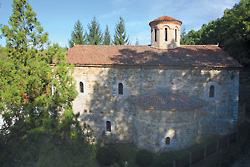 A series of impressive presentations of St. Christopher with an animal’s head was made in Mt. Athos in the first half of the XVIII century: in the Great Lavra in 1715, in Karakalu in 1717, Vatoped and Chilandar in 1740. They are all said to be creations of Greek painters. The icon kept in the Museum in Recklinghausen is from the same period. Vasilije Rafailović, the last master of the famous painting family from Risan, painted the icon of the dog-headed St. Christopher in the Church of St. Nicholas in the Monastery of Gradište, above the village of Buljarice, near Petrovac upon the Sea in 1796. A series of impressive presentations of St. Christopher with an animal’s head was made in Mt. Athos in the first half of the XVIII century: in the Great Lavra in 1715, in Karakalu in 1717, Vatoped and Chilandar in 1740. They are all said to be creations of Greek painters. The icon kept in the Museum in Recklinghausen is from the same period. Vasilije Rafailović, the last master of the famous painting family from Risan, painted the icon of the dog-headed St. Christopher in the Church of St. Nicholas in the Monastery of Gradište, above the village of Buljarice, near Petrovac upon the Sea in 1796.
A fresco from the village of Donji Korminjani near Gnjilane from the XIX century initiated Patriach Pavle to write his work on St. Christopher in 1976. Originating from the same century are frescoes in the Church of the Ascension of Virgin Mary in the Monastery of Sukovo near Pirot (1857/1858), as well as from the Church of St. John in Gornji Matejevac near Niš (1863). Also close to them, both in time and style, is St. Christopher from the Monastery of Pure Virgin Mary in Kičevo (1880/1881).
FROM THE FATHER, THROUGH THE SON, IN THE HOLY SPIRIT
There are maps, reviews, descriptions.
What about explanations for this very unusual holy character?
Already Plinius and Pseudo-Kalisten wrote about the dog-headed ones. The folk legends, including Serbian ones, also keep numerous similar stories. Patriarch Pavle contributes a nice sketch of possible interpretations. Papaevangelou, in his Iconography of St. Christopher (Athens, 1968), points out that further origins could be sought in the ancient Egyptian myth about the god Anubis. He had the head of a jackal, similar to a dog, and carried Ore over the Nile. ”The posture, painting of the profile, the environment, the blossoming stick, everything is the same in both of them”, points out the Patriarch. There is also a clear connection with the presentation of the Greek hero Heracles, who carries little Dionysus on his shoulder.
 In her analysis of the clothes worn by dog-headed St. Christopher at the presentations, Ljiljana Stošić says: ”The cloak, the male upper dress, the traveler’s or warrior’s pelerine, or a halamida similar to today’s pelerine, is one of the characteristic attributes of all demons of the Lower World (Hades, Hermes, Thanatos). In Christian tradition, the cloak is worn by Archangel Michael, and in Serbian folk beliefs, the cloak is related to a werewolf or vampire. The fact that the cloak has superpowers is also supported by the legend that its owner losses his powers if his cloak is taken away or hidden, just like the dragon losses his strength after losing his shirt...” In her analysis of the clothes worn by dog-headed St. Christopher at the presentations, Ljiljana Stošić says: ”The cloak, the male upper dress, the traveler’s or warrior’s pelerine, or a halamida similar to today’s pelerine, is one of the characteristic attributes of all demons of the Lower World (Hades, Hermes, Thanatos). In Christian tradition, the cloak is worn by Archangel Michael, and in Serbian folk beliefs, the cloak is related to a werewolf or vampire. The fact that the cloak has superpowers is also supported by the legend that its owner losses his powers if his cloak is taken away or hidden, just like the dragon losses his strength after losing his shirt...”
Above all, iconology based on the super-religious Sacral Tradition in the legend about the dog-headed St. Christopher sees the brief history of salvation. The path of the repeated deification of the fallen human in nature, the path of reintegration, ”return to our heavenly homeland”. From the animal-like, through the humane, to the holy (divine). Just like a plant turns substance from the earth, through itself, into fragrance (ether, spirit).
From the Father, through the Son, in the Holy Spirit.
***
Nomen est omen
The Latin root of his first name Reprobus (Reprob, Reprobus) means worthless, rejected, the cursed one. Opposite of Probus (worthy, honest). However, it also signifies one who, after having passed the fire of great temptation, regains original purity and goodness.
And Christopher is, as we have stated, the carrier of Christ. The one who carried Christ.
Between the two names is the life of this Holy one.
The name is the fate.
***
Patriarch
Pavle (Stojčević) was then, in 1976, the bishop of Raška and Prizren. He regularly answered questions and dilemmas of believers in Glasnik SPC, and in March that year he answered the question regarding Saint Christopher from Donji Korminjani near Gnjilane. In this text he is presented as an exceptional Christian Orthodox scholar and excellent writer, and his famous with also came to the fore.
”... Such image can be found on one medallion on an icon in the Church o St. Nicholas of Gradište Monastery near Bar in Montenegro, which is, in a tourist guide by Branko Živković and Boro Radonjić resolutely called ‘St. Donkey’”, writes the future patriarch of Serbia. ”It is not easy to explain how they came to the conclusion that he was presented here as the ‘Holy Donkey’, since the image has small ears, similar to dog’s or horse’s, but certainly not donkey’s, except if it were not for tourist attraction or evidence of religious bigotry and stupidity.”
***
Nazor
Vladimir Nazor (1876-1949) from Brač, poet, writer, the one who, after seeing the savage Croatian crime against the Serbs at Vrginmost in 1943, wrote the famous poem ”Orthodox Mother”, made a romantic novel Legend of St. Christopher and published it in three parts in the Serbian Literary Herald in 1922, in editions 4 (February 16th), 5 (March 1st) and 6 (March 16th). The editor was Svetislav Petrović, and directors Bogdan Popović and Slobodan Jovanović.
|
